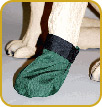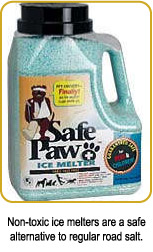


Christmas Store
The holidays are just around the corner so now is the time to fetch the finest gifts for the Labrador Lover on your Christmas list. We have over 100 gifts $50.00 and under. Visit our Christmas Store.
For the Lab
Bedding
Coats
Collars and Leads
Dog Bowls
Feeding Stations
Spa and Grooming
Toys and Treats
Travel and Accessories
For the Lab Lover
Apparel
Cards and Giftwrap
Fine Accessories
Gifts and All Occasions
Jewelry
Kids Only
For the Lab Home
Artwork
Books
Garden and Outdoor
Home Furnishings
Kitchen Accessories
Pillows, Throws, and Rugs
Gift ServicesGift Boxes
Gift Certificates
Winterizing Your Lab
Inclement weather, snow, ice, and the chemicals used during winter all have the potential to cause serious problems for our animals. Especially if your four-legged one is a puppy, elderly or in ill health, limit your dog's time outdoors during bitter weather. Keep your Lab from roaming the neighborhood, where despite your best efforts at home, he could find ethylene glycol (antifreeze) elsewhere. The major issue in winter continues to be antifreeze poisoning- it's almost always fatal.
Antifreeze

One of the tasks people routinely do to prepare for winter is to add antifreeze to their vehicles. Antifreeze products usually contain one of three active ingredients: ethylene glycol, propylene glycol, or methanol. Ethylene glycol is the ingredient found in most antifreeze products, most commonly at a concentration of 95% to 97%. It is an extremely dangerous toxin, being approximately three times as toxic as propylene glycol. A small amount left on the ground can be lethal to man's best friend if he happens to lap it up. According to the ASPCA's Poison Control Center, less than a tablespoon can be lethal to a 20-pound dog. Even smaller quantities can still make an animal critically ill.
Antifreeze poisoning normally occurs when pets become exposed to antifreeze leaking from a car's cooling system or when antifreeze is changed. Sometimes antifreeze is placed in home plumbing systems when heat will not be maintained during winter months (such as a summer cottage). When this is done it is extremely important to remember to flush the system well prior to letting pets in the house. There also have been cases where pets have been exposed to antifreeze poisoning maliciously.
Ethylene Glycol
Antifreeze, containing ethylene glycol, smells and tastes good to dogs. Its sweet taste attracts pets and ingesting even a tiny amount causes fatal kidney toxicity. In the dog's body, ethylene glycol is metabolized by the liver into 3 major compounds. Metabolites (in the form of oxalates) are most toxic to the kidneys. Oxalates, when combined with calcium, form crystals, causing blockages of the tubules in the kidneys, "acute renal tubular necrosis." Ethylene glycol also changes the pH of the blood to be more acidic ("metabolic acidosis") and can cause central nervous system and respiratory depression. There are three stages of ethylene glycol poisoning:
-
0-12 hrs. After exposure to the ethylene glycol, central nervous system signs will develop in as short a time as 30 minutes to approximately as long as 12 hours, depending on the dose ingested. Depression, signs of intoxication, "drunkenness" similar to alcohol ingestion, vomiting, drop in body temperature, seizures, stupor, rarely coma, and death may occur among the initial signs of poisoning. These signs normally last less than 12 hours in dogs causing some owners to think the danger has passed
-
12-24 hrs. Cardiovascular system signs including increased heart rate and increased respiratory rate can be seen.
-
12-72 hrs. In dogs, the kidney problems usually show up one to three days after ingestion of the antifreeze. Formation of urine drops off until urine is not produced at all. This severe renal failure causes vomiting, sores in the mouth, a noticeable increase in oral odor, severe depression and then eventually coma and death.
Treatment must be initiated very promptly for the dog to survive. Dogs do best if treated within five hours of ingestion of the antifreeze. After eight hours post ingestion, the chances of survival diminish rapidly. For this reason, it is extremely important to consider the possibility of antifreeze poisoning anytime there are unexplained central nervous system disorders that occur in your Lab. If you see or suspect your Lab has ingested antifreeze, take him to your veterinarian immediately!
Propylene Glycol

Caution should also be used while working with the new antifreeze made from propylene glycol. Propylene glycol can be toxic to dogs, but less so than ethylene glycol. Antifreeze products containing propylene glycol, usually at a concentration of 50% or less, such as Sierra and Preston LowTox are safer and are unpleasantly flavored to prevent ingestion. These safer products will not metabolize into oxalate and attack the kidneys, but could affect the nervous system and may cause lack of coordination and seizures.
Methanol
For dogs, methanol is the least toxic of the ingredients, however, it is very toxic to humans. Methanol can also be found in some windshield washer fluid. If only a small amount is ingested, only mild gastric upset is seen. In any case of suspected ingestion, contact you veterinarian. Larger amounts may cause metabolic acidosis, retinal damage, and seizures, requiring immediate veterinary attention.
Prevention
To prevent this tragedy, care should be taken to avoid spilling any or allowing any to remain in a puddle on the ground when changing or adding antifreeze to your car. Don't allow your Lab access to the area when draining radiator fluid from a vehicle. Properly dispose of any empty antifreeze containers and rags. Antifreeze containers should be wiped clean and stored out of reach from your pets. Regularly check your vehicles for antifreeze leaks. If you see a puddle of greenish-colored liquid in your driveway, flush the area with plenty of water and don't delay locating and fixing the leak. If your standard practice is to take the car to a mechanic for its winter preparations, be sure to ask specifically for propylene glycol based antifreeze. Keep your Lab from roaming and finding antifreeze elsewhere.
Walking in the Cold

Icy walkways are not only dangerous for us two-legged creatures, but for our four-legged friends as well. Slipping on the ice is of special concern for older dogs that may already be stiff due to arthritis. Snow and ice are also dangerous because they can cut into the pads of your Lab's feet. You can purchase products that toughen and strengthen the pads and feet of dogs, or you can go the route of dog boots. You might laugh, but more and more dogs are wearing them, especially after 911. Whatever type of boots you purchase, make sure they are easy to put on. Dogs don't like to stand still for a long time while you attach strange things to their feet.
Dog boots will also help to protect your Lab's feet from the salt, magnesium, or calcium chloride used to melt ice from sidewalks. Dogs develop irritation on their paws from salt. They get reddened and then the dog tends to lick them a lot. Ice melt compounds, when ingested can cause stomach upsets, and even nerve damage.

Get in the habit of checking your Lab's feet after a walk. Make sure the pads are not cracked or dried out. Baby oil rubbed on and between the pads can help keep pads pliable and eliminate ice build-up when snow and slush cover the ground. If you don't remove salt, the foot pads can crack and erode, causing lameness. Rinse the paws in some warm water to remove any chemicals. Even if you don't see any salt or sand on your walk, it may be there and get into the area between the toes.

To prevent salt from hurting your Lab's feet, you could use a non-toxic ice melter like Safe Paws for your own sidewalks. Snow collecting between the toes can be very painful, and can even obstruct blood flow to the toes. Keep the hair between the toes and pad well trimmed to avoid snow sticking to them and turning to ice balls. Good nail care is important, too. Nails that are too long also reduce traction. They force your Lab to walk on the backs of his feet, splaying his toes. The greater the space between his toes, the more snow will pack up between them. Help your Lab remove these collections of snow while you are out walking. Remember to keep your Lab away from ponds or lakes that may have thin ice.
Dress your Lab for the weather, especially if they reside indoors all the time, or are elderly or quite young. Dog coats, such as the one we offer in the store, make a handsome yet functional way to help your Lab fight the chill, and look smashing while doing it. Common sense will tell you when to use a coat. If you are walking consistently, your dog will build up a heavier fur coat and this will help.
Housing Outside

If you keep your Lab outside, provide a dry, insulated house facing away from the wind. Having a wind- break is critical. The house can be homemade, but the new insulated plastic models available today are inexpensive and designed especially for comfort in cold weather. Take advantage of the sun's warmth by putting the doghouse on the east or south side of your home. Make sure the doghouse is not too large. A correctly sized doghouse should allow your Lab just enough room to comfortably lie down and turn around. A doghouse that is too large will not trap and hold your dog's body heat to provide proper insulation in keeping your Lab warm. Preferably, the doghouse will be placed on top of insulation or on a low platform to keep it off the frozen ground. Your Lab should have a mat or bed inside the doghouse, but be careful not to use anything like blankets or quilts that can trap moisture and make your dog damp, chilly, and uncomfortable. The house should have a door or heavy flap over the entrance to keep out drafts. Keep an eye on the temperature; when it falls below 20 degrees or on particularly raw days, you may want to consider bringing your Lab in to give it a break from the cold. Frostbite, the death of tissue in extremities due to freezing, on tails and tips of ears can occur in severely cold weather.
Dogs who are outside in cold weather will need extra calories to keep warm. When the temperature is below freezing, you may need to increase calories as much as 30%, depending on the dog and housing conditions. Regularly check your Lab's water to make sure it's not frozen. Dogs need fresh water available to them all day, especially in winter when their bodies are apt to get dehydrated. Dogs can't burn calories without a fresh supply of water, and if they can't burn calories, they'll get cold. A twice daily watering may not be enough depending on your temperatures. Another thing to consider, switching to a dark, heavy plastic, deep dish for your water bowl. Plastic bowls don't freeze as quickly as metal bowls and dark colors absorb heat from the sun. A deeper dish will freeze less quickly than a wide, shallow one. Dehydration will make him more vulnerable to the cold. It may also cause him to drink from contaminated puddles or spills containing antifreeze.
If you live in an area that gets a lot of snow, keep the snow from piling high next to your fence. A packed snowdrift will provide a boost for your Lab to jump over the fence and escape the safe confines of your yard.
Frostbite is a common danger during winter. It can affect toes, ears, and scrotum. Initially the skin appears white but once circulation is re-established, the area becomes red and swollen and may begin to peel. If your Lab does get frostbite, soak the affected parts with tepid water for 15-20 minutes. Do not rub the area, simply pat dry. Keep the dog warm and seek veterinary help since further treatment may be needed. As sensation returns, the dog may feel pain. It is necessary to prevent biting at the skin and causing further injury.
Hypothermia is a major concern during cold weather. Inadequate shelter, calories, or becoming wet can make a dog much more susceptible to this condition. Shivering is a sign that your Lab is too cold and indicates the start of hypothermia. If you suspect hypothermia, dry the dog off by rubbing vigorously with a towel. Then wrap a warm blanket around the dog and take its rectal temperature. If the temperature is below 98.5 get to a vet or emergency clinic immediately. Continue to keep the dog warm but avoid overheating.
Carbon Monoxide Poisoning
Carbon monoxide poisoning is another potential problem for pets kept in the garage with vehicles during winter months. Never start your car and let it warm up in the garage unless you remove your pet during this time.
Housing Inside
During the cold winter months, many people use space heaters and wood-burning stoves. Do not allow unsupervised dogs in areas with space heaters, which could be tipped over. It is far healthier for your Lab to keep your home as cool as is comfortable. They are more comfortable and will shed less. Blame your Lab's far-from-lustrous coat on exposure to the contrasting temperature extremes of the blustery outdoors and warm indoors. If your Lab is indoors more at this time of the year, it's probably getting less exercise and may need less food.
For arthritic dogs, provide an orthopedic or warmed bed. There are several on the market, basically the equivalent of a heating pad but won't cause the burns that human heating pads and electric blankets can.
Try to get out with your Labs each week on mild days and take a walk or play in the yard. They are great at making snow angels or chasing a snowball or two, just remember not to overdo it.
 Can You Spot The Holiday Hazards?
Can You Spot The Holiday Hazards?It’s easy for pets, especially Labradors, to get into trouble during the holidays. You may get so busy that you lose track of what is going on with your dog.
Click here to learn more about: "Can You Spot The Holiday Hazards?"

Would you like to see your Lab pictured here? Send us images of your Lab and we may include them on our Home Page!
Labrador Links
The Verstaile Lab
History of the Lab
Advice
Travel
Featured Labs
Featured Artists
.jpg)

